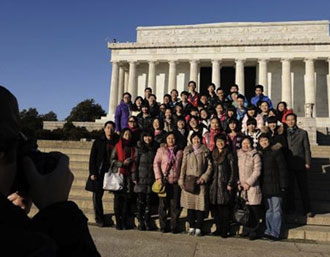Some of the biggest victims of the US government shutdown are tourists who spent thousands of dollars to travel from Asia only to find many marquee attractions closed.
The Yellowstone National Park, Lincoln Memorial, the Smithsonian National Museum and the Statue of Liberty are among the most popular of the attractions run by the federal government. Including the 401 national parks, these attractions have been turning away about 715,000 visitors a day since the shutdown Tuesday.
Of those about 35,000 a day are from Asian nations. Most will never have another chance to visit the sights around which they had planned their US trips. For them the shutdown represents a loss of much of the value of the typically several thousand dollars per person spent to fly to the US, stay in hotels and dine in restaurants.
“I want to cry,” wrote a Chinese visitor to her WeChat friends of her disappointment after waiting so long for her US vacation then learning that she won’t be able to see the Statue of Liberty, the Lincoln Memorial and other sights.
“Nobody will give any compensation to these Chinese tourists,” grumbled Tony Lu, an LA-based tour operator who caters to Chinese visitors. “The Senate and the Congress will definately not. And we have to do more to make them feel better, such as explaining the situation to them and helping some of them modify their travel plans. Hope the federal government shutdown ends soon.”
“Compared to the 1995-1996 shutdown, this time is more serious to us,” he added. “We run mostly Chinese market business and there are much more Chinese tourists groups now than 17 years ago.”
Nearly 1.5 million Chinese visited the US in 2012, according to the Commerce Department’s Office of Travel and Tourism Industries.
Japanese tourists too are facing the same intense disappointment due to the first partial US government shutdown in 17 years. Among them may be two classes of second-year students at Osaka-based Uenomiya Senior High School. As part of their “Power Course” aimed at helping them enter top-tier national and public universities, they are planning to travel to the US east coast for a week in early November. They are hoping the shutdown will end before they visit New York where the Statue of Liberty is one of their main destinations.
Japanese and Korean tour companies in California are faced with the unenviable task of trying to find suitable substitutes for mega-attractions like the Grand Canyon and Yosemite National Park. Airlines and travel agencies are also facing a torrent of cancellations and reservations changes as travelers try to shift travel plans in hopes of landing in the US after the shutdown ends. Given the current state of negotiations between the White House and the GOP-dominated House of Representatives, there’s no assurance that the shutdown will end in time to save their vacations.


